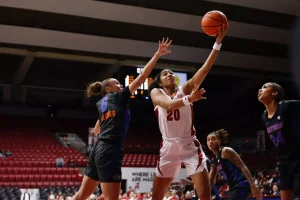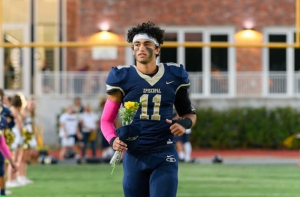Media failed in wake of Bryant’s death
January 30, 2020
In many ways, journalism failed on Sunday.
Basketball legend Kobe Bryant was killed in a helicopter crash in Calabasas, California, along with his 13-year-old daughter Gianna and seven others. The news came as a bombshell, devastating sports and entertainment fans worldwide.
But, in the wake of Bryant’s death, some questions remain regarding the work journalists did over the weekend and beyond. Most importantly, why did reporters feed into narratives that were simply wrong? Then, after the dust settled, how shall we choose to remember Bryant: as a beloved father and sports star, or as a man whose troubling legal past should continue to haunt him in his death?
EXAMINING ETHICS
In journalism, there are loyalties that drive our ethics. Whether we’re loyal to our publications, to our communities or simply to ourselves, one thing is paramount: We must always remain loyal to the truth.
At 1:34 p.m., TMZ Sports tweeted a link to an article reporting that Bryant had died in a helicopter crash with “at least three others” on board. Madness ensued, as local and national reporters retweeted an article that was not completely factual. Some perpetrators of radical misinformation included ABC, NBC and many local affiliates.
False reports made their rounds on the internet, as some claimed that Bryant was the only member of his family to die in the crash. Other outlets stated that his entire family was aboard, while some linked Bryant’s former teammate, Rick Fox, to have also died in the crash.
“My family went through, in the midst of all of this, something that I couldn’t have imagined them experiencing,” Fox said on TNT’s tribute to Bryant’s life. “One of my daughter’s greatest fears is finding out that a parent or one of her parents would be lost through social media instead of a loved one or a family member.”
Fox continued to show the impact of the false reports as his phone rang incessantly with Fox’s friends and family calling him for updates. Meanwhile, Bryant’s wife Vanessa was not even alerted of his passing before social media lit up. What is lost in the consistent false news reports is that the other seven members who were in the crash were not identified by the media until hours after.
Three other families also lost loved ones in that crash. They also dealt with the same false information regarding the accident and while the world began to mourn Bryant and Gianna, the Altobelli, Mauser and Chester families were still waiting to hear what happened that morning.
These are the moments that define us as journalists and as people.
In journalism, two qualities can make or break a career: integrity and credibility. This weekend, some major news outlets lost the latter. Journalists cannot blame their mistakes on the “non-stop news cycle” or the race to report. One of the most crucial rules in journalism is to get the facts straight, and many outlets failed to do this in favor of being first.
As an industry, we need to ask ourselves: If our objective is to be the first to report news rather than be accurate, what we are doing this for?
It’s not our place to call for someone’s job over mistakes we could just as easily make, but we hope this editorial serves as a gentle reminder to media professionals on how to react and respond in a time where accuracy and courtesy are most imperative.
LAYERS OF LEGACY
As the saying goes, you should not speak ill of the dead, but there is a conversation that needs to be had about Bryant’s legacy and whether it deserves to be as spotless as fans wish it could be.
Journalists’ readers have to realize that every story is layered and we cannot talk about such a renowned pop culture icon without examining all the layers he left. That being said, Bryant’s posthumous media coverage has been overwhelmingly positive, with any criticism of his sexual assault charges being dismissed, its authors subject to ridicule and anger. But we believe Bryant’s legacy would not be complete without considering the worst parts of him, some of which are equally as important – if not more – than his athletic achievements.
In June of 2003, Bryant traveled to Edwards, Colorado, to have knee surgery. The then-24-year-old stayed at The Lodge and Spa at Cordillera, where he was accused of raping a 19-year-old employee of the hotel the night before he had the procedure. Bryant was arrested, then proceeded to change his story about the night’s events during the investigation. At first, he denied ever having sex with the woman, then changed the story to say he did have sex with her, but that it was consensual. The victim had bruises on her neck, which Bryant attributed to having “strong hands” and that strangling sexual partners was “his thing.” He was arrested on July 4, then was immediately released on a $25,000 bond.
The charges were later dropped, as the victim refused to publicly testify. Bryant issued a public apology after the dismissal, remarking on his remorse for the victim. A civil case was filed shortly thereafter, and Bryant settled for an undisclosed amount. According to an article in the Los Angeles Times, legal experts estimated that the settlement could have surpassed $2.5 million.
This case has followed Bryant for much of his career, though some would argue his reputation was recovered mostly in full. He went on to earn the NBA’s Most Valuable Player title in 2008, won five championships and regained major endorsements from Spalding and Coca-Cola. As many obituaries have pointed out, Bryant also devoted much of his retirement to his family, co-founding Mamba Sports Academy and becoming a paternal icon with Gianna. As a women’s athletics advocate and father to four girls, Bryant’s life ended in a season of redemption. And while we would love to believe that his legacy should only be positive, we cannot allow Bryant’s alleged victim to be forgotten in the time of his death.
Yes, the charges were dropped. There were inconsistencies with the criminal case. Evidence was botched, and speculation was rampant – but we cannot use these excuses to conveniently forget a teenager’s suffering. Having difficult conversations like these matters, because without them we will never evolve into a society that can openly discuss rape and sexual assault allegations without immediately dismissing the victim. Especially given the rise of celebrity accusations since the #MeToo movement began, it is imperative that we do not lose sight of the victims who often live in the shadow of the accused.
Simply, Bryant’s criminal history is complicated, but the purpose of writing is not to solve complicated things. In fact, this case may never see a concrete resolution. However, to ignore this is to be inaccurate. Our duty as journalists is to lay out the facts and simplify the layers of topics like these for our readers to consider. Our hope is that Bryant’s legacy is defined accurately, completely and without reservation.
Our mission as journalists is to realize and report the entire story. We treasure Kobe Bryant as an incredible athlete. We love him as a women’s sports advocate and #GirlDad, but we also must remain cognizant and vigilant in remembering him as a rape suspect and a man whose path to redemption was cut short.










